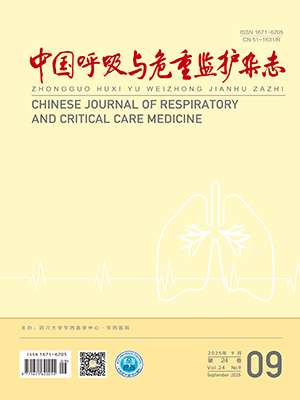| 1. |
Roberton BJ, Hansell DM. Organizing pneumonia: a kaleidoscope of concepts and morphologies. Eur Radiol, 2011, 21(11): 2244-2254.
|
| 2. |
Lee JW, Lee KS, Lee HY, et al. Cryptogenic organizing pneumonia: serial high-resolution CT findings in 22 patients. Am J Roentgenol, 2010, 195(4): 916-922.
|
| 3. |
Oikonomou A, Hansell DM. Organizing pneumonia: the many morphological faces. Eur Radiol, 2002, 12(6): 1486-1496.
|
| 4. |
Hansell DM, Bankier AA, MacMahon H, et al. Fleischner Society: glossary of terms for thoracic imaging. Radiology, 2008, 246(3): 697-722.
|
| 5. |
Travis WD, Costabel U, Hansell DM, et al. An official American Thoracic Society/European Respiratory Society statement: update of the international multidisciplinary classification of the idiopathic interstitial pneumonias. Am J Respir Crit Care Med, 2013, 188(6): 733-748.
|
| 6. |
Wells AU, Hirani N. Interstitial lung disease guideline: the British Thoracic Society in collaboration with the Thoracic Society of Australia and New Zealand and the Irish Thoracic Society. Thorax, 2008, 63: v1-v58.
|
| 7. |
中华医学会呼吸病学分会. 社区获得性肺炎诊断和治疗指南. 中华结核和呼吸杂志, 2006, 29(10): 651-655.
|
| 8. |
Nambu A, Ozawa K, Kobayashi N, et al. Imaging of community-acquired pneumonia: roles of imaging examinations, imaging diagnosis of specific pathogens and discrimination from noninfectious diseases. World J Radiol, 2014, 6(10): 779-793.
|
| 9. |
Baque-Juston M, Pellegrin A, Leroy S, et al. Organizing pneumonia: What is it? A conceptual approach and pictorial review. Diagn Interv Imaging, 2014, 95(9): 771-777.
|
| 10. |
Faria IM, Zanetti G, Barreto MM, et al. Organizing pneumonia: chest HRCT findings. J Bras Pneumol, 2015, 41(3): 231-237.
|
| 11. |
Marchiori E, Zanetti G, Escuissato DL, et al. Reversed halo sign: high-resolution CT scan findings in 79 patients. Chest, 2012, 141(5): 1260-1266.
|
| 12. |
Rea G, Lassandro F, Valente T. Exogenous lipoid pneumonia in laryngectomy patients: Is ground glass opacity/crazy paving pattern an organizing pneumonia reaction that can predict poor outcome?. Arch Bronconeumol, 2016, 52(8): 438-439.
|
| 13. |
Nei T, Yamano Y, Sakai F, et al. Mycoplasma pneumoniae pneumonia: differential diagnosis by computerized tomography. Intern Med, 2007, 46(14): 1083-1087.
|
| 14. |
Dai J, Shi JY, Soodeen-Lallo AK, et al. Air bronchogram: a potential indicator of epidermal growth factor receptor mutation in pulmonary subsolid nodules. Lung Cancer, 2016, 98: 22-28.
|
| 15. |
Jung JI, Kim H, Park SH, et al. CT differentiation of pneumonic-type bronchioloalveolar cell carcinoma and infectious pneumonia. Br J Radiol, 2001, 74(882): 490-494.
|
| 16. |
Cadranel J, Wislez M, Antoine M. Primary pulmonary lymphoma. Eur Respir, 2002, 20(3): 750-762.
|
| 17. |
Gudmundsson G, Sveinsson O, Isaksson HJ, et al. Epidemiology of organizing pneumonia in Iceland. Thorax, 2006, 61(9): 805-808.
|
| 18. |
Ward E, Rog J. Bronchiolitis obliterans organizing pneumonia mimicking community-acquired pneumonia. J Am Board Fam Pract, 1998, 11(1): 41-45.
|
| 19. |
Banka R, Ward MJ. Bronchiolitis obliterans and organising pneumonia caused by carbamazepine and mimicking community acquired pneumonia. Postgrad Med J, 2002, 78(924): 621-622.
|
| 20. |
Rea G, Pignatiello M, Longobardi L, et al. Diagnostic clues of organizing pneumonia: a case presentation. Quant Imaging Med Surg, 2017, 7(1): 144-148.
|
| 21. |
Feinstein MB, DeSouza SA, Moreira AL, et al. A comparison of the pathological, clinical and radiographical, features of cryptogenic organising pneumonia, acute fibrinous and organising pneumonia and granulomatous organising pneumonia. J Clin Pathol, 2015, 68(6): 441-447.
|
| 22. |
Huo Z, Feng R, Tian X, et al. Clinicopathological findings of focal organizing pneumonia: a retrospective study of 37 cases. Int J Clin Exp Pathol, 2015, 8(1): 511-516.
|




